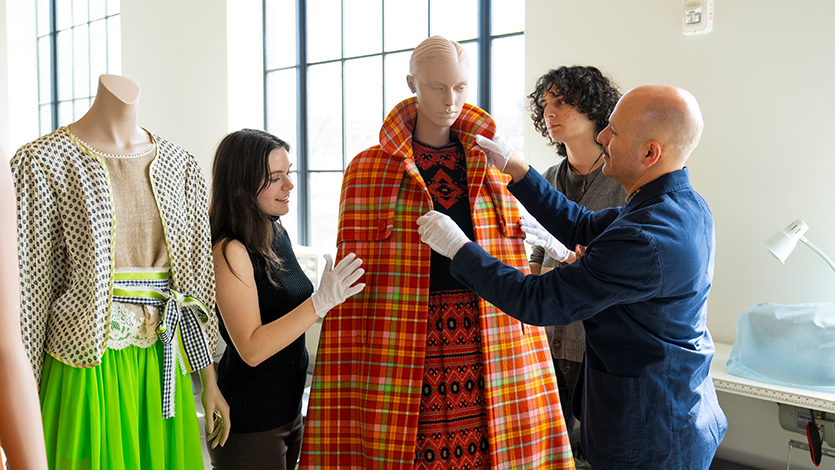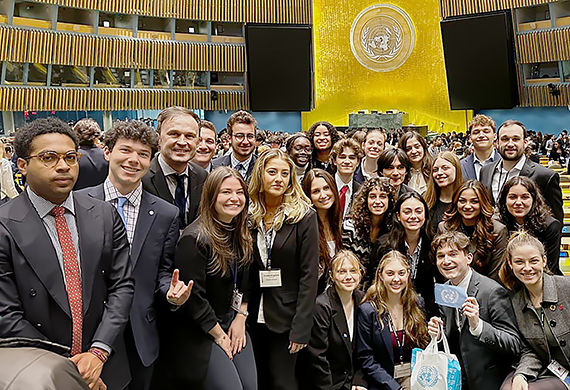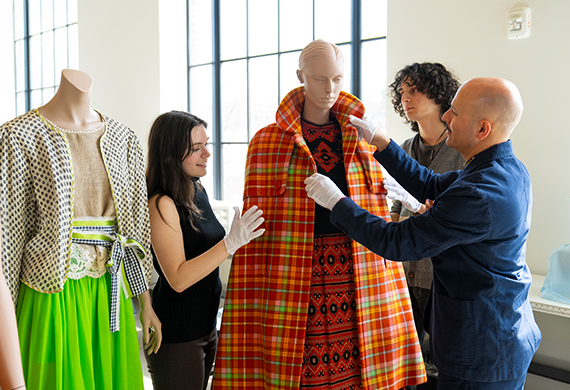Steel Plant Archive Now Features Geoffrey Beene Collection

April, 29, 2025 — Marist’s fashion archive is now home to 68 ensembles from Geoffrey Beene, one of the most influential fashion designers of the 20th century.
This significant addition to the University’s collection of historical garments was made possible by a donation from Dr. Sylvia R. Karasu, a former client of Marist fashion design professor DooRi Chung, who previously served as head designer for the Geoffrey Beene brand.
"When you have a donor who sees what we’re doing at Marist and says, ‘I would like to make this kind of large and significant donation,’ it really helps to elevate the program,” said Mario Roman, visiting lecturer of fashion history and costume, who oversees the archive.
Geoffrey Beene was known for his minimalist yet sophisticated designs, which emphasized craftsmanship and innovative construction. The donated collection spans from the late 1960s to the early 2000s, offering a comprehensive look at the designer’s evolution over the course of his career.
Real-world Fashion Experience On Campus
The fashion archive, which is located on the second floor of the Steel Plant and now houses about 500 pieces that are carefully maintained and preserved, was established under former program chair Radley Cramer with the goal of providing students access to historical garments for study.
The archive offers unmatched hands-on learning opportunities and real-world experience, right from Marist’s Poughkeepsie campus. Garments are regularly incorporated into fashion history courses and used by design and merchandising faculty to provide historical context in their teaching.
From left to right: Professor Mario Roman, Matteo DeVito '26, Libby Clark '26, and Haley Hartman '25 work with garments from the fashion archive. Photo by Carlo de Jesus/Marist University.
"When students see some of the intense structures that older garments have, it does blow their minds," Roman said. "That makes history tangible, and it also shows students designs and techniques that we just don't do anymore."
Students engage in what Roman calls 'object analysis,' examining garments up close to study construction techniques, materials, and design elements. These exercises connect historical context with practical skills, preparing students for careers in design, vintage markets, or appraisal.
Under Roman’s supervision, the archive is moving forward with a focus on donations. The Beene collection represents a model for future growth.
Student Workers at the Helm
A dedicated team of student workers is essential to maintaining and cataloging the archive, particularly the new Beene collection.
"One of the best parts about working in the archive is getting to research the stories behind individual garments," said Libby Clark '26, a fashion merchandising major with a concentration in fashion promotion. "It's incredible to take what seems like just a beautiful piece on the surface and see how it plays into a much larger narrative."
Matteo DeVito '26 (on ladder) and Libby Clark '26 in the fashion archive. Photo by Carlo de Jesus/Marist University.
For Matteo DeVito '26, a fashion design major with a product development minor, the archive provides a unique opportunity to see different construction techniques that have helped him to create his own works.
DeVito, whose grandmother is a seamstress, particularly values the physical interaction with historical pieces.
"My favorite part of working in the archive is being able to look closely at the garments and find all the details," he said. "There aren't many opportunities for me to see garments like this aside from the internet, and it is more valuable to be able to physically interact with them."
Fellow student worker Haley Hartman '25, a fashion merchandising major with a concentration in promotion, is a self-described “history nerd” who appreciates the meticulous nature of archive work.
"My favorite part about working in the archive is cataloging. It's fun to put my knowledge to the test," she said.
Haley Hartman '25 in the fashion archive. Photo by Carlo de Jesus/Marist University.
Spotlighting Education through the Beene Donation
The Geoffrey Beene donation is particularly valuable for the learning potential it provides.
“When you collect designer garments, that significantly elevates the archive because typically the materials and construction techniques are of higher quality,” said Roman. "Students have the opportunity to see how a designer has changed across time, but also how designers may revisit materials, techniques, or themes throughout their career."
It also puts the fashion in context. Designer garments allow students to compare high-end items with more accessible ones and understand how manufacturing has changed throughout history, for example.
For fashion students like Clark, this experience is invaluable.
"Handling his work up close gave me a much deeper appreciation for Beene’s minimalist approach," she said. "His pieces are a reminder that simplicity can be incredibly intentional and expressive."
The archive team aims to complete cataloguing the Beene collection this semester, but beyond the immediate work of organizing the garments, the mission of the archive is to further reflect the goals of Marist 100, guiding future acquisition and educational efforts.
"You may not think of 'expansive community' as being important to a historic archive, but it actually is," Roman said. "It's important that students see themselves reflected in an archive that is meant to represent the diversity of fashion and how it has changed over time."



